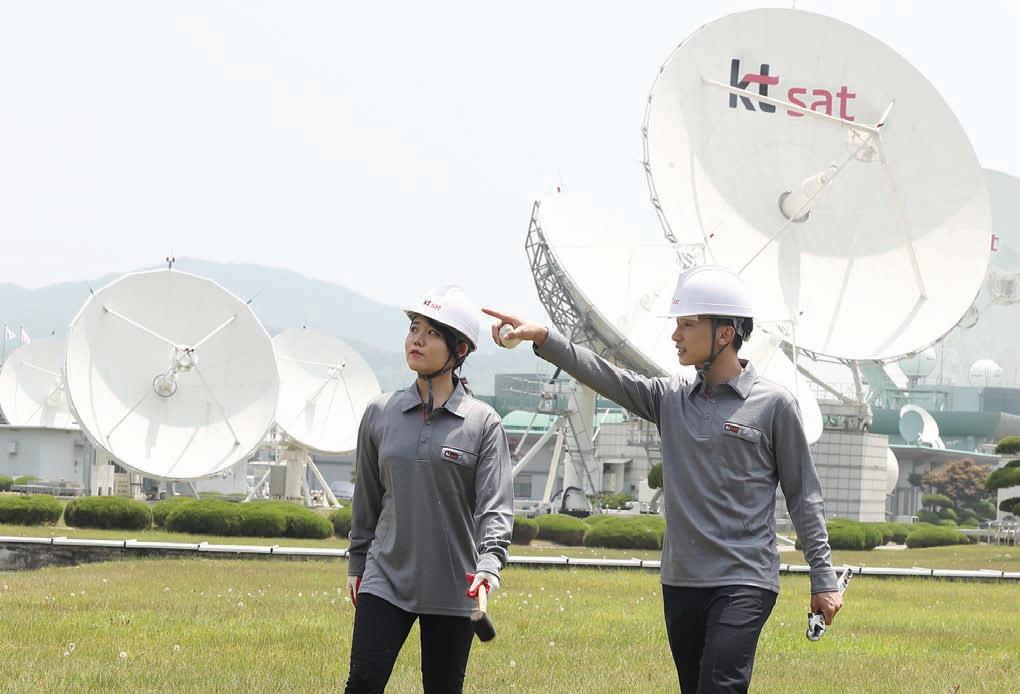
8 minute read
Delivering connectivity across a wide range of sectors
KT SAT has long been a powerful satellite developer, both in orbit and on the ground. Delivering connectivity across a wide range of sectors, the company has seen the industry from many angles and is well placed to discuss the market’s evolution in the Eastern world. We spoke to KT SAT about what they anticipate for the APAC region and their perspective on the West.
Laurence Russell, Associate Editor, Satellite Evolution Group
Question: What were KT SAT’s latest achievements, and how were they delivered?
KT SAT: KT SAT aims to be a global provider of multi-orbit satellite connectivity services from GEO to NGSO. KT SAT finished an International Telecommunications Union (ITU) filing for a LEO Constellation along with a technical constellation design. Also, KT SAT made an investment in Mangata Networks, a US-based start-up that plans to provide MEO satellite service. KT SAT expects its service will be more stable and reliable when it does business using multiple orbits.
One of our most recent achievements is the launch of our space data service, providing Earth observation imagery, video, and analytics data through an AI-powered geospatial analytic platform. KT SAT plans to first tap into the domestic market to formulate customer use cases, with the aim to expand its service to the global market by focusing on creating value-added services in data analytics and applications, areas that have great potential for future growth.

KT SAT technicians pictured at a company ground station. Photo courtesy KT SAT
Question: You unveiled a new maritime product, XWAVE, earlier this year to target the Southeast Asian region. How did your launch perform, and how has the service performed so far?
KT SAT: Currently our customers using the XWAVE service consist of more than 1,650 vessels globally. Regional MVSAT features allow for expanded coverage of the Asiatic oceans from the Bay of Bengal, Indonesia, and the western seas of Australia to the Indian ocean on an unlimited highspeed network (2Mbps).
To expand its market to Southeast Asia, KT SAT made a contract with Singapore-based partners and proceeded with on-site customer meetings with 13 vessel management companies in May. In June, KT SAT participated in CommunicAsia 2022, the largest global satellite conference in Asia-Pacific Region where we met with customers from Singapore, Malaysia, Indonesia, and the Philippines.
KT SAT’s MVSAT offering also includes various valueadded services optimized for vessels. KT SAT plans to offer value-added services using ICT technology like CCTV, network management systems, broadcasting services, etc. with a goal to improve work efficiency as well as to provide secure operation in vessels.
Question: Last year, KT SAT’s President Song Kyung-min proposed a “LEO Alliance” at the Euroconsult World Satellite Business Week 2021. In your eyes, why is a collaborate-to-compete strategy superior?
KT SAT: Regional GEO operators need to secure enough satellite capacity through NGSO to enhance business competitiveness. As we’ve experienced, barriers to entry can be harsh, but a high tide can raise all ships. With effective collaboration, we can all benefit from a more dynamic market.
Question: Western markets have a limited understanding of the East Asian market and the trends and policy directions that inform it. How best can we bridge these gaps to create a more efficient global economy?
KT SAT: Recently, major players in the satellite industry, mostly from the western market, have started to provide their NGSO connectivity service to the East Asian market. To enter that market, they have to solve regulatory issues like licenses, administrative procedures, requirements of regional providers, etc. On the other hand, KT SAT has already secured a wide business share in East Asia along with a strong reputation of trust. It just makes sense to try to establish partnerships with other operators to acquire a broad range of satellite connectivity including GEO, LEO, and MEO, and we welcome global partners becoming a part of that.
Question: You attended CommunicAsia in Singapore this June. What were your impressions of the show, and what did KT SAT showcase at the event?
KT SAT: We resumed our offline showcase after Covid 19 starting from CommunicAsia 2022 and promoted our service and technology including our space data service which provides high-resolution satellite imagery and AIpowered analytics data. Through KT SAT’s space data service, customers can get a clearer picture of activities that give immediate benefits to the defence and intelligence community for security, supply chain, and other critical needs.
The service is also a hybrid solution, a technology that allows more reliable data communication than traditional 5G with flexibility coordinating across different networks. It offers seamless connectivity through satellites which outlasts potential disconnections in terrestrial networks. KT SAT expects this to be a next-generation network solution because it aggregates many means of connection under one service, from satellites to LTE, 5G, Wi-Fi etc. As the so-called NewSpace era continues, we expect the importance of hybrid solutions will grow as they continue to integrate across orbits.
Question: From your perspective, how do you believe the East Asian market will evolve in the next decade? What will be the West’s influence on the market, and do you foresee monopolisation or disruption? Do you believe China will begin behaving like the US in economic policy and work towards a larger space start-up segment while being open to collaborating more with its neighbours?
KT SAT: East Asia is a set of continuously growing economies just as mature as those in the West, with a high demand for satellite data like broadband, mobility, and the requirements of government. Before the days of NewSpace, KT SAT saw the growth potential of the East Asian market to expand quite naturally, potentially serving parts of the West, but with the explosive growth of players like SpaceX, which plans to target East Asia with its Starlink service, the picture has become more complex. It will be interesting to see how market share disseminates in the wake of such bold moves.
If providers like SpaceX are serious about tackling Asian markets, there will be many hurdles to overcome ranging from regulatory issues to coordination with regional providers – especially in Indonesia. Another issue is making their satellites compatible with existing connectivity infrastructure. We don’t exactly anticipate a SpaceX monopoly, but they are sure to affect the market supply in ways that fly in the face of our economic expectations over the last decade. KT SAT will continue its effort to provide world-leading satellite service through strategic cooperation with regional operators.
With regards to China, space development has typically been considered a national business, but as the NewSpace era dawns, we’ve seen growing participation from their private sector. The space industry was once exclusive to a small selection of advanced economies, but the connected nature of the world means global-facing start-ups can dive into this industry from anywhere.
China will go on exploring space commerce in the private sector after its initial successes to gain ground that the US has started to claim. China has a strong history in space technology and is a formidable economic competitor. They have the potential to make significant inroads in these new markets. We anticipate that China’s progress will be accelerated by a commercial approach, favouring start-ups, and encouraging greater degrees of collaboration with its neighbours to secure the best conditions for growth.

KT SAT’s President Kyung Min Song proposed a “LEO Alliance” at the Euroconsult World Satellite Business Week 2021
Question: What can we expect from KT SAT in the year ahead?
KT SAT: KT SAT plans to provide a total satellite service including not only connectivity but also Earth observation, and navigation. For more than 50 years we have delivered incomparable service and technology to the satellite industry. It’s that reputation for excellence that has led to the set of government projects we’ll be serving. The first is the KASS (Korean Augmentation Satellite System) project, a national business operated by the Korean government for improving the accuracy and reliability of global positioning system (GPS) signals to ensure flight safety.
The second is the KPS (Korean Positioning System) project, another government business developing sovereign GPS for South Korea. KPS will improve the accuracy of Korea’s GPS services, which South Korea heavily relies on, and which will be essential to supporting the infrastructure of the nation by paving the way for drone and autonomous vehicle navigation.
Through these prestigious projects, KT SAT will continue growing its capabilities in satellite navigation, and honing its competitive edge, while remaining open to partnerships overseas to strengthen its data analytics and range of applications.






